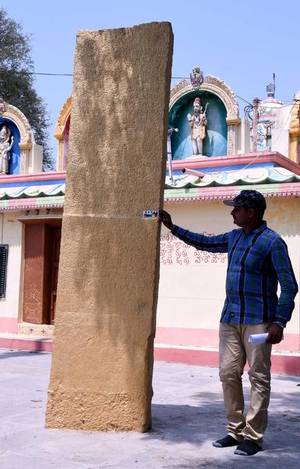
Telugu-Sanskrit words engraved on undated stone edifice may offer insight into the region’s rich cultural heritage
A stone inscription, believed to date back to 13th Century A.D., standing majestically on the premises of Venugopala Swamy temple in Rajeshwarapuram of Nelakondapalli mandal, is waiting to be explored to offer an insight into the region’s glorious cultural heritage.
The ten-foot high undated stone inscription located adjacent to the Dwajasthambam on the precincts of the temple has stayed intact withstanding the vagaries of nature, but remained unexplored till date.
The inscription has several lines etched in Telugu-Kannada script akin to the pattern prevalent during the Kakatiya period. An impressive image of Lord Garuda adored with Shankam and Chakram is engraved on the top portion of the stone inscription.
Located about 30 km from Khammam on the Nelakondapalli-Kusumanchi main road, Rajeshwarapuram has a hoary past as is evident from a fort situated in the middle of the village albeit in a dilapidated condition and an old well that served as a prime source of irrigation during the bygone era.
The Telugu-Sanskrit words engraved indicate that it is related to donation of land to “Veeragopala devara” temple probably during the Kakatiya period, says historian Katta Srinivas, who recently conducted an independent study in Rajeshwarapuram on the historical significance of the village.
Sun, moon images
The stone edifice contains the images of sun and moon engraved on the top portion of it reinforcing the fact that it is an inscription. He stresses the need for establishing the exact date and other historical facts by enlisting the services of experts in epigraphy.
Rajeshwarapuram is endowed with historic structures, including a fort and an ancient irrigation structure besides Shaivite and Vaishnavite temples existing side by side, he notes, insisting on the intervention of the Archaeology Department to unravel the rich history of the village and conserve the historical edifices for posterity.
“Our village is part of Nelakondapalli mandal, the abode of ancient Buddhist Mahastupa and also the birthplace of legendary saint composer Bhakta Ramadasu,” says Veeranageswara Rao, a native of Rajeshwarapuram. The ancient Siva temples dating back to the Kakatiya period in Kusumanchi mandal are located just over 10 km from the village and the culturally rich region has potential to secure a prominent place on the tourism map of Telangana, he says with a sense of pride.
source: http://www.thehindu.com / The Hindu / Home> News> States> Telangana / by P. Sridhar / Khammam – April 23rd, 2018